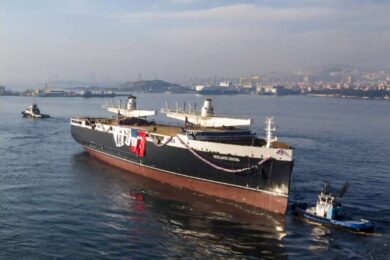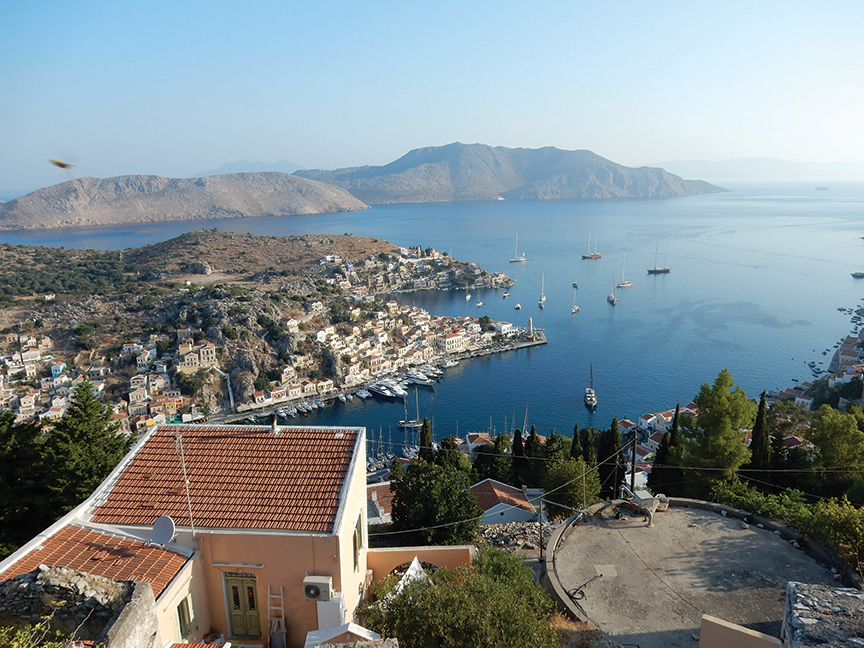The Dodecanese Islands of Greece (published October 2015)
We were cruising the Turkish coast for six weeks aboard Celador, a 41-foot Beneteau, and enjoying Turkish culture, history and food. Offshore, islands floated in the haze. They were the Dodecanese, a string of twelve Greek islands lying close along the coast of the Turkish mainland.
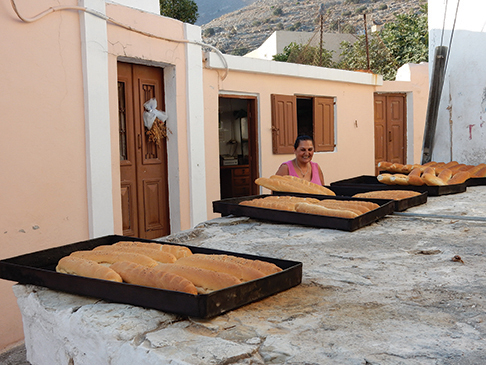
Without the meltemi, the northwest wind of this region, in calm seas we motor sailed for Symi, which is a port of entry for Greece, and much easier to clear into than bustling Rhodes. It’s a arid rocky island devoid of greenery on the south end, with some reforestation evident around Symi town in the north. It’s past was made prosperous by sponge fishing and shipbuilding, up to 500 vessels per year, which could account for the bare sunburned slopes. We rounded a head and motored into the harbor and were met on the quay by the harbor captain who directs and assists with mooring.

The town is extraordinary. Classic facades are meticulously painted in white, ochre and terra cotta, some trimmed in green. Others are shades of periwinkle blue. They line the waterfront and climb up the hillsides, connected by steep winding steps. At the taverna just across from our mooring, we had a light
dinner of saganaki and sweet red pepper stuffed with feta cheese, and were given access to Wi-Fi we could use on the boat. At night, the town is colorfully lit and alive with people strolling and enjoying the cafe life.
Early in the morning we climbed to the high town, crowned by a church, overlooking neatly painted buildings and picturesque ruins. We were streaming with sweat by 9:30 a.m. and on the way down, a stop under a shady arbor for iced coffee was most welcome. We enjoyed a breakfast of green melon, yogurt and the last of our Turkish stone-oven bread, then sailed to return to Marmaris to finish some boat business.
The southernmost island of the Dodecanese is Kastelorizo, nestled inside a bay near Kas, Turkey. We motored slowly into the small, picturesque harbor of Megisti. As we slowly approached the quay, we noticed only a few visiting yachts; there was a lot of open space at the quay. We were thinking we were lucky. The owner of a nearby taverna waved at us to back up to the quay. I dropped the anchor when Ron gave the word. We backed in, tied on our stern lines and adjusted them, then went ashore for happy hour at a cheerful quayside taverna. It was charming, scenic, and not very crowded. Neighborhood cats quietly circled under the tables looking for morsels. We were walking back to the boat when a local gentleman sitting at a table near the quay told us that the bureaucracy would be along pretty soon to collect local docking fees adding up to around 75 Euros. He explained that these fees were the reason there were so few yachts visiting, and it was not helping the local economy at all. Well, happy hour was over! We decided to move to Kas in Turkey, just a few miles away where, for less money we would have amenities such as water, power and showers.
On the bow, I proceeded to bring the anchor chain up too fast and piled it up, causing the chain to jump off the gypsy. It ran out freely and alarmingly as we swung wide in the fairway (harmlessly, thank goodness). I didn’t know what to do. Ron came forward and used the windlass handle to lever the running chain over to one side to slow and finally stop its run. I hooked on the snubber, he pulled some chain from the locker up and over the gypsy, and the windlass was ready to use again. Off we sailed, and within an hour we were moored again, this time in the cushy marina. We were sorry to miss Kastelorizo. Hopefully the fees will be adjusted to be more cruiser-friendly.

Volcanic Nisyros lies west of Knidos off the Turkish coast. Nisyros is a small and friendly place, accessible only by yacht or ferry. We moored up in the tiny village of Pathoi, and watched the sun set over gyro and moussaka at the “Captain’s Place”, about 20 paces from Celador.
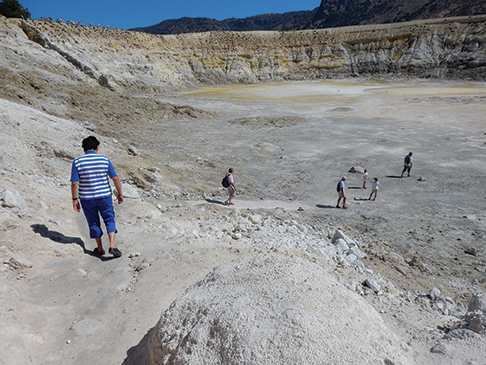
The next day, right after breakfast, we toured the island by motorbike. This island is greener than most we’d seen. Almost every hillside has been terraced extensively with dry stone walls over the generations. Little stone huts are built into the hillsides here and there, blending into the landscape. In earlier times grapevines, peppers, onions, potatoes, tomatoes, grain, and olive trees were cultivated. Today no crops are planted, but fig, olive, and scrub oaks shade the terraces, their trunks leaning in to the old stones. The road snaked higher and higher, and the air cooled, scented by dry grass and rosemary. Topping a crest, we could now see the caldera of the volcano which formed the island.
We followed the winding ribbon of road down and down to the bottom where farm fields blanket the crater bottom. Ahead lay the volcano national park. Entering, we saw cinder cones and cliffs of sulfur-streaked rock; it is primal, timeless, unconquerable. Following a footpath down to the center of the newest crater, the ground sounded hollow underfoot and there were bubbling mud pots. Fumaroles steamed, rimmed with sulfur crystals. Satisfied (and slightly unsettled) with our explorations, we regrouped over cool drinks and continued our ride. Zig-zagging up out of the valley we came to a scenic little village perched on the highest edge of the crater, white cubes clustered together on the ridge top. We had a light lunch of cheese and Greek salad topped with pickled caper-vine leaves and crusty bread with olive oil.
In the front room of the cafe was a broken mercury glass mirror in an old, ornately carved wooden frame, and next to it hung a faded sepia-toned portrait of a young officer. The host explained that the Athenian soldier was killed in this doorway during WWII, the mirror broken by a German bullet. They still honor his memory. Walking through the tiny village, we found the “natural sauna”, a little room built over a volcanic vent. We rode further, down to the town of Mandraki to visit the town and castle. The streets are lovely narrow lanes with whitewashed houses and painted doorways. Many had interesting brass knockers, door knobs and artistic decorations. Wandering toward the monastery, we enjoyed sweeping views of the white cubist town, with the hazy sea and islands in the distance. We climbed uphill to the edge of town, past ruins of farm cottages hidden among the hillside terraces, up and up to the walls of the fort. Massive black volcanic blocks formed the walls of the Hellenic battlements. We explored the fort, climbing to the top of the walls, beholding sweeping views of the horizon lost in sea mist.
Returning to Pathoi we had dinner and drank red wine in the cockpit, watching the sailors having fun in the cafes along the quay. As the night wore on, the cafes quieted down and the tavernas livened up. At Saloniki Taverna, traditional Greek music inspired a young Greek man with a ponytail to start a circle dance, slow and stately. Tipsy German sailors joined enthusiastically with their own interpretations.
Aboard Celador, we laughed and chatted in the cockpit, growing sleepier. One by one everyone but me retired to sleep. I’d been yearning to go over and dance, and thought—the time is now! I tiptoed over the passerelle and hurried over. As I
entered, the young man smiled and beckoned me to join him and the Germans. “It’s not hard” he said, “it is one step left and two right”. An old lady sitting nearby smiled when she saw I had learned the step. The song ended too soon, and it was late. The
old lady stood and with a sweeping gesture, announced “Kali
Nichta”…good night, this party’s shutting down. I shook hands all around and returned to my berth, smiling as I went to sleep with a special travel moment to cherish.
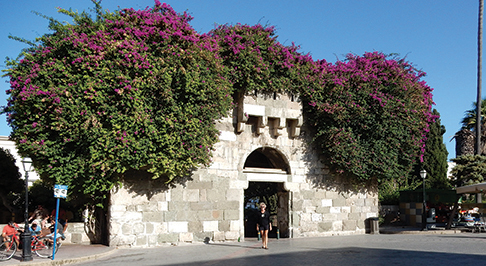
The next day we departed early for Kos. The meltemi was forecast to blow hard, so we opted to ride it out in comfort and safety at modern, posh Kos Marina. The sky was clear blue, and the gale lasted for three days. We were happy to be snug and secure. Seas were breaking over the seawall and late-arriving boats were battling tumbling waves and rippling wind, eager to be escorted to sheltered slips.
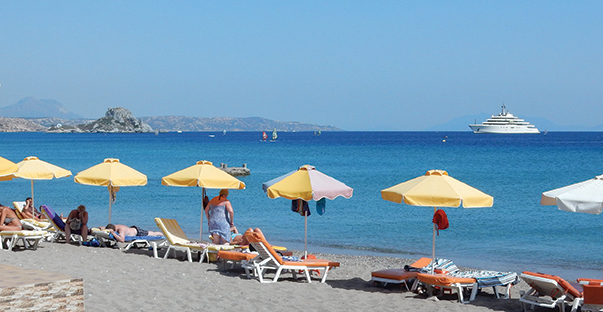
Kos town is interesting, with classical Greek columns and agora, medieval Hospitaller forts, Ottoman mosques, and Venetian-style
hotels nestled cozily and randomly amid the modern buildings of the town. It was the birthplace of Hippocrates, and his modern views of medicine took root and spread throughout the Hellenic world from here.
We spent a few days leisurely exploring the streets and lanes of Kos. Shops selling Greek souvenirs such as worry beads, reproductions
of classical sculptures (of varying quality), ice cream stalls
and cafes serving tiny cups of rich coffee offer plenty of browsing
and places to sit, watch people and catch up on the news of the world.
After three days of exploring of Kos town, and with the wind still strong, we decided to
board the public bus for a tour of the countryside. Just off the main road
lies the Askepion, an ancient medical center based on the teachings of
Hippocrates which emphasized cleanliness and healthy diet as a
foundation of treatment.
The bus traveled along the main road to the western end of the island. The housing and landscape are modern and nondescript, concrete boxes sitting on bare land. Olive groves and evergreens dotted the landscape from time to time. We began to think there may not be much to see on this trip. Then we rounded a bend just past Paradise Beach…a spectacular vista came into view. It was Kefalos Bay with its golden sand beach and hat-shaped island adorned with a tiny chapel with a blue vaulted roof. Stately mountains overlook the bay from the west. An elegant sailing yacht and a mega yacht rode quietly, sheltered from the gale there…a note we made for future reference. We immediately decided to hop off here. We strolled through the town, enjoyed a seaside lunch and beach walk, collecting colorful jasper stones smoothed by the sea.
The next day we motorsailed once again to the pretty port of Symi, one of my favorite
stops on this trip. We stayed for three days, wandering the shops
and galleries, climbing stairs through the neighborhoods and to
churches overlooking the harbors. Since autumn had arrived, the cooler
temperatures permitted more comfortable trekking, so we decided to climb the
steps to the high town and walk down over the crest to Pedi town,
a six mile round trip. We hiked up through the neighborhoods of Symi town and descended into more workaday areas, with some small industrial facilities and the power plant. We passed a ruined house with a rickety grape arbor and picked sun-ripened black grapes and sweet raisins to snack on. On the return trip we stopped at a cafe and enjoyed Greek coffee with sweet plum and
carrot cake. After this, it was time to return to the boat and clear out for our return to Turkey.

Although they are near the Turkish coast, the islands of the Dodecanese are delightfully Greek. The Greek people we met were friendly and outgoing. Our voyage through the Dodecanese was limited by time, but we hope to visit again when Celador sails in the spring.

